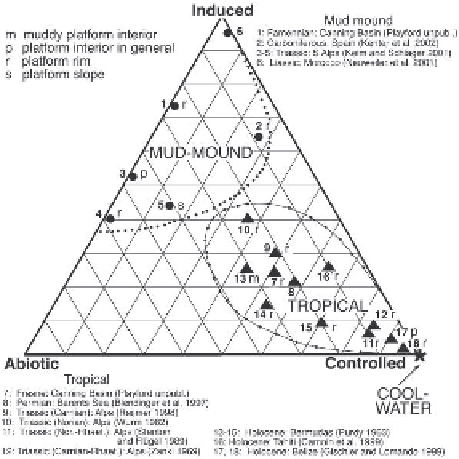Geology Reference
In-Depth Information
The earliest quantitatively important coccolithophorids
appeared in the Triassic, reached rock-building quality
in the Jurassic and became the main elements of pe-
lagic carbonate rocks during the Cretaceous and Ter-
tiary (see Sect. 4.1.1; Fig. 15.37).
cementation. The factory operates in warm, sunlit wa-
ters, high in oxygen and low in nutrients.
• The
cool-water factory
is characterized by biotically
controlled precipitates and dominated by heterotrophic
organisms. A contribution of photo-autotrophic organ-
isms (red algae, symbiotic larger foraminifera) may,
however, be significant. The sediment typically con-
sists of a skeletal hash of sand- to granule size. Shoal-
water reefs and ooids are absent. Carbonate mud and
abiotic marine cements are scarce. The environment
of the cool-water factory is aphotic or photic water that
is cool enough to exclude competition by the warm-
water tropical factory and sufficiently winnowed to
prevent the deposition of terrigenous fines. Water depths
range from upper neritic to bathyal.
• The
mud mound factory
is
characterized by biotically
induced and quasi-abiotic precipitates, usually micrite.
The fine-grained carbonate precipitated in situ (auto-
micrite). The typical environment of the mud-mound
factory is dysphotic or aphotic, nutrient-rich waters low
in oxygen but not anoxic. These conditions often pre-
vail at intermediate depths, below the mixed layer of
the sea.
16.7.2 Differences in Phanerozoic Benthic
Carbonate Factories
Chapter 9 stated that 'limestones are biological sedi-
ments' and that most limestones are directly or indi-
rectly influenced and controlled by biological pro-
cesses. Purely physicochemical carbonate precipitation
has been discussed for the formation of some micrites
or 'non-skeletal' components like carbonate cements
and ooids. Biological or organic triggers are also un-
der discussion for the formation of these components.
Schlager (2003) established a threefold conceptual
framework distinguishing the various degrees of biotic
influence on the precipitation of benthic marine car-
bonate sediments (Fig. 16.25):
•
Abiotic (or quasi-abiotic
) precipitation with neglige-
able biotic effects.
•
Biotically induced
precipitation where organisms
trigger biochemical processes. The category includes
precipitation driven by energy inherited from life pro-
cesses (organo-mineralization; see Fig. 4.2), and pre-
cipitation driven by living organisms influencing
physico-chemical conditions, leading to biomineral-
ization (mainly microbial precipitates). These processes
contribute to the formation of mud mounds and are ef-
fective in the formation of seep and vent carbonates
(Sect. 16.5).
•
Biotically controlled
precipitation where organisms
determine the location, beginning and end of the pro-
cess, and commonly also the composition and crystal-
lography of the mineral. This category includes all skel-
etal carbonates.
These processes are key elements used in a classifi-
cation distinguishing three benthic carbonate factories
(Fig. 16.25) representing end members related by tran-
sitions in space:
• The
tropical factory
is characterized by (a) biotically
controlled precipitates from photo-autotrophic organ-
isms (e.g. algae) and animals with photosynthetic al-
gae, such as hermatypic corals, certain foraminifera and
certain bivalves, and (b) abiotic precipitates in the form
of marine cements and ooids. Heterotrophic organisms
are common as well as the construction of wave-resis-
tant structures by organic frame-building and/or rapid
Fig. 16.25.
Benthic shallow carbonate factories.
Proportions
of abiotic, biologically induced and biologically controlled
material in the tropical, mud-mound and cool-water carbon-
ate factory. Tropical factory and mud-mound factory are mix-
tures of the three categories and grade into one another with
the mud-mound factory centered on the induced and abiotic
material, and the tropical factory centered on biologically
controlled material. The cool-water factory consists almost
entirely of one category. The graph is based on published
compositional data or point counts of published microphoto-
graphs of thin sections. Slightly modified fromSchlager
(2003).

